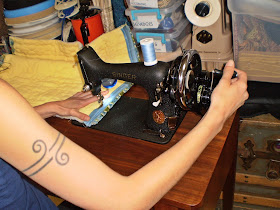Often it is the beautiful antique or vintage quilts that survive, because they were "saved for good". My mother only got the very best linens out when my paternal grandparents were visiting. That's the only time she ironed the sheets, too! But not all antique/vintage quilts are valuable or beautiful. Here is a case in point.
Those of you who put photos online will know that they never really look like the original object. This quilt looks much better in the photo than it does in real life. The pink is Pepto-Bismol pink, and it it overwhelming in its pinkness. Especially since I hung it on the wall in a small bedroom, where it dominates the room. Guests who sleep in this room will probably have nightmares about being savagely attacked by the Pink Panther.
In any creative endeavor, it's always a good thing to analyze what does not work.

The solid pink and blue block doesn't look too bad in the photo above. In real life, the two pinks are so similar that the house disappears and all that is left is a confusing collection of blue shapes.
The block with the large blue polka dots is another one that just doesn't look like a house.
The quilter really liked the blue polka dots. She used them three times.


She liked these brown stripes just as much, and it might seem that the stripes would suggest architectural structures. But sadly, no.
The pink used with the blue stripes is another pink that just disappears into the pink background.


Which blocks do work? It's pretty obvious, and is also one of the basic rules: CONTRAST.
Using two strongly contrasting colors, ONE OF WHICH IS NOT PINK, makes these houses visible on the quilt as houses.
On the other hand, the strong contrast makes these stand out from the pastels of the rest of the quilt in a jarring way. Not a good thing.
Now that I have analyzed it, I will also confess that I absolutely love this quilt. I love the choices that the quilter made. I would have made many of them myself. Stripes and polka dots, why yes, of course! Pink, pink, and more pink? Bring it on!
This quilt came from a NC thrift shop, and I paid all of $5.00 for it. I followed DragonPoodle Studio Maxim Number One: all incoming textiles go into the washing machine, gentle cycle, with detergent and hot water and OxiClean on the same day they arrive. Yes. Really. Here's why: Kill all the lurking life forms right away. Know the worst about the performance of the item right away. Brighten the color as much as possible and make as many of the stains as possible go away.
Should you do this also? What YOU should do is figure out for yourself what is important to you and not let anyone else tell you the right way to do things.
Textiles are ephermal, meaning that they are going to disappear sooner or later. The reason the Stone Age is called the Stone Age and not the Dawn of Fibers Age is that the fibers have all disintegrated by now. Only the stone remains. Wouldn't you just love to know what those folks were doing with plant fibers? But I digress.
The detergent and the OxiClean may hasten the deterioration of the fibers. But moth larvae and mold spores and dirt and grime will also hasten it, and I have just dealt with them. And I am not doing this to museum-quality, historically significant textiles. My shopping is done at the bottom of the market, not the top. I'm rescuing items headed for the landfill.
The Pepto-Bismol pink of this quilt was a much more subdued brownish pink before its trip through the washing machine. It looked more "antique" then. Does it now look more like its original appearance? I like to think so, but I don't really know. It is decades old, and colors change over time.
I always mean to blog more frequently. Then I don't. Mostly I have been working on refurbishing vintage sewing machines lately. Someday I might even show you! But while we are both waiting for that to happen, here is one more piece of eye candy, a gift to me from blogging buddy Wilma of
Wilma's World.
Very cute, very cozy, and very appropriate since I met the DH when we were both in grad school at Carolina.
If you are a careful follower of Wilma's blog, you may notice that I played a little trick with the image above. First person (other than Wilma) to post a comment below in which you tell me what this was will win a crocheted spool pin doily. Wilma, maintain your silence until we have a winner, please!
I'll send you one also, Wilma, if you email me your snail mail address. I've been going crazy crocheting spool pin doilies lately. You'll have a choice of traditional red, pink variegated (looks good on the green Singers) or a bubble gum pink. The red felt one at the end is included here for size comparison.
Keep the guesses coming! I won't reveal the correct answer for at least a week, to give everyone a chance to get in on it. Could be multiple winners also--told you I went crazy with these.

























































